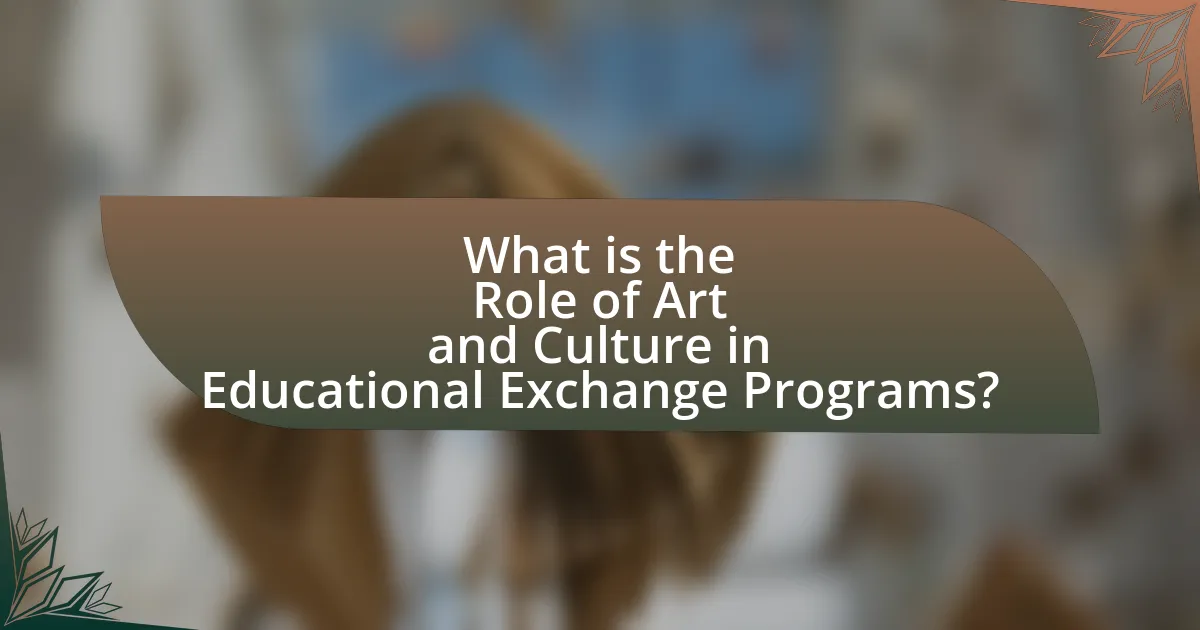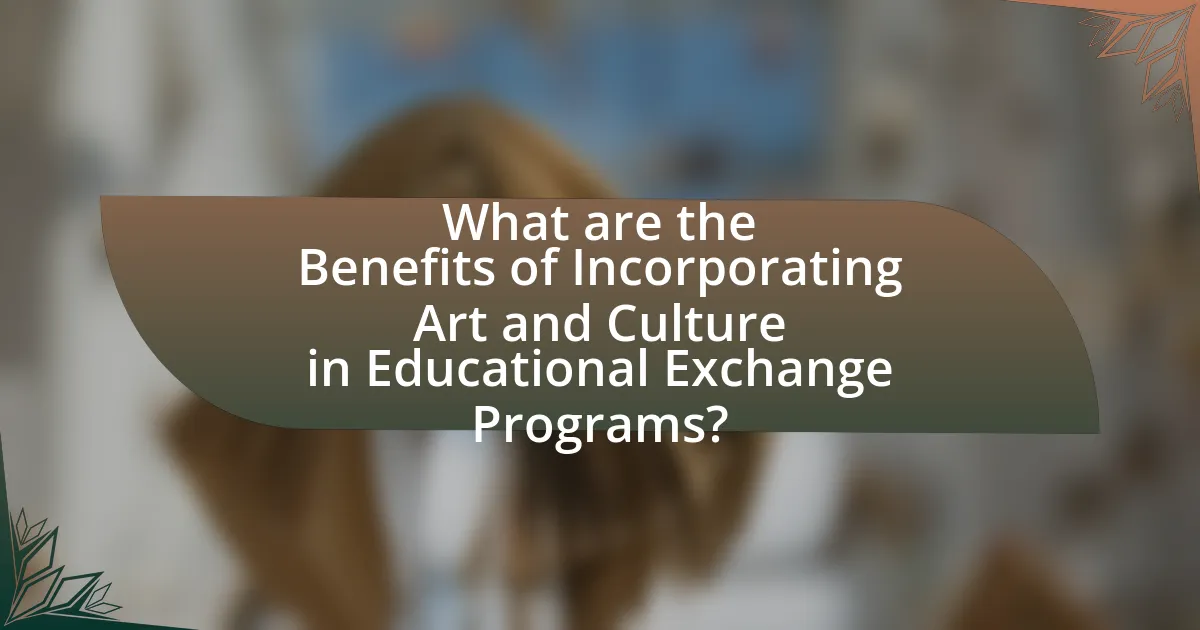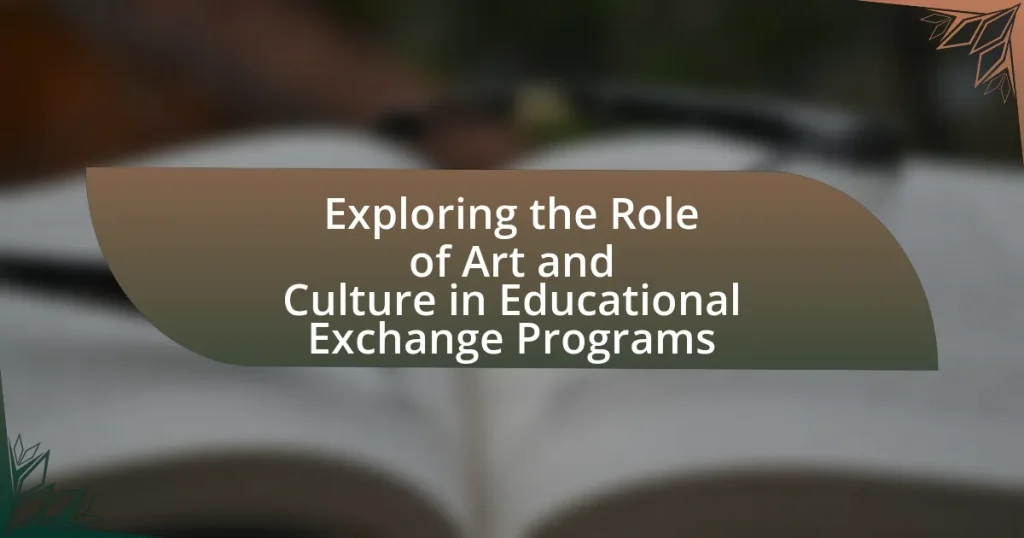The article explores the significant role of art and culture in educational exchange programs, highlighting how these elements foster cross-cultural understanding and enhance learning experiences. It discusses the integration of various cultural practices, such as traditional art forms and community engagement activities, which promote empathy and global citizenship among participants. The article also examines the benefits of cultural immersion, the skills developed through engagement with diverse cultures, and the advantages for educational institutions. Additionally, it addresses the implementation of art and culture in these programs, the impact of technology, and best practices for successful execution, providing a comprehensive overview of how art and culture enrich educational exchanges.

What is the Role of Art and Culture in Educational Exchange Programs?
Art and culture play a crucial role in educational exchange programs by fostering cross-cultural understanding and enhancing the learning experience. These programs often incorporate artistic expressions and cultural practices, which serve as tools for participants to engage with and appreciate diverse perspectives. For instance, studies have shown that exposure to different art forms, such as music, dance, and visual arts, can significantly improve empathy and social skills among students. Additionally, cultural activities, such as traditional festivals or local crafts, provide immersive experiences that deepen participants’ knowledge of the host country’s heritage. This integration of art and culture not only enriches the educational curriculum but also promotes global citizenship and intercultural dialogue, essential components in today’s interconnected world.
How do art and culture influence the objectives of educational exchange programs?
Art and culture significantly influence the objectives of educational exchange programs by fostering cross-cultural understanding and enhancing global citizenship. These programs often aim to immerse participants in diverse artistic traditions and cultural practices, which cultivates empathy and appreciation for different perspectives. For instance, research by the Institute of International Education indicates that students who engage in cultural exchanges report increased awareness of global issues and improved intercultural communication skills. This alignment with educational goals underscores the importance of art and culture in shaping the objectives of such programs, ultimately preparing participants to navigate an interconnected world.
What specific cultural elements are integrated into these programs?
Educational exchange programs integrate specific cultural elements such as traditional art forms, local customs, language immersion, and community engagement activities. These elements enhance participants’ understanding of the host culture, fostering cross-cultural communication and appreciation. For instance, programs often include workshops on indigenous crafts or music, which provide hands-on experiences that reflect the cultural heritage of the region. Additionally, language immersion is a critical component, as it allows participants to learn the local language in context, facilitating deeper connections with the community. Community engagement activities, such as volunteering or participating in local festivals, further immerse participants in the cultural fabric of the host society, promoting cultural exchange and understanding.
How does art serve as a medium for cultural exchange?
Art serves as a medium for cultural exchange by facilitating communication and understanding between diverse cultures. Through visual arts, music, dance, and literature, artists express cultural narratives, values, and experiences that resonate across borders. For instance, international art exhibitions, such as the Venice Biennale, showcase works from various countries, allowing audiences to engage with different cultural perspectives. This interaction fosters dialogue and appreciation, as evidenced by studies indicating that exposure to foreign art can enhance cultural empathy and awareness. Thus, art not only reflects cultural identity but also acts as a bridge that connects people from different backgrounds, promoting mutual respect and collaboration.
Why are art and culture essential in fostering global understanding?
Art and culture are essential in fostering global understanding because they serve as universal languages that transcend barriers of nationality, ethnicity, and ideology. Through artistic expression and cultural practices, individuals can share their unique perspectives and experiences, promoting empathy and connection among diverse populations. For instance, UNESCO emphasizes that cultural exchange enhances mutual respect and appreciation, which are crucial for peaceful coexistence. Additionally, studies show that participation in cultural programs can lead to increased tolerance and reduced prejudice, as individuals engage with and learn from different cultural narratives.
How do cultural experiences enhance learning outcomes?
Cultural experiences enhance learning outcomes by providing diverse perspectives that foster critical thinking and creativity. Engaging with different cultures allows learners to develop empathy and adaptability, which are essential skills in a globalized world. Research indicates that students who participate in cultural exchange programs demonstrate improved academic performance and greater cultural awareness. For instance, a study by the Institute of International Education found that 90% of students who studied abroad reported enhanced problem-solving skills and increased self-confidence. These experiences not only enrich knowledge but also promote social and emotional development, leading to more effective learning outcomes.
What role does art play in bridging cultural gaps among participants?
Art serves as a vital medium for bridging cultural gaps among participants by fostering understanding and empathy. Through visual arts, music, and performance, individuals from diverse backgrounds can express their unique cultural narratives, allowing others to engage with and appreciate different perspectives. For instance, collaborative art projects in educational exchange programs have been shown to enhance cross-cultural communication, as participants share their stories and experiences through creative expression. Research indicates that such interactions can lead to increased cultural awareness and reduced stereotypes, as evidenced by studies conducted by the National Endowment for the Arts, which highlight the positive impact of arts-based initiatives on community cohesion and intercultural dialogue.

What are the Benefits of Incorporating Art and Culture in Educational Exchange Programs?
Incorporating art and culture in educational exchange programs enhances cross-cultural understanding and fosters creativity among participants. These programs expose students to diverse artistic expressions and cultural practices, which can lead to increased empathy and appreciation for different perspectives. Research indicates that students engaged in culturally rich environments demonstrate improved critical thinking and problem-solving skills, as they learn to navigate and interpret various cultural contexts. For instance, a study by the National Endowment for the Arts found that students involved in arts education are more likely to excel academically and socially, highlighting the positive impact of integrating art and culture in educational settings.
How do participants benefit from exposure to diverse artistic expressions?
Participants benefit from exposure to diverse artistic expressions by enhancing their cultural awareness and fostering empathy. Engaging with various art forms allows individuals to understand different perspectives and experiences, which can lead to greater appreciation of cultural diversity. Research indicates that exposure to diverse artistic expressions can improve critical thinking and creativity, as participants learn to interpret and analyze different styles and messages. For instance, a study published in the Journal of Educational Psychology found that students who participated in arts-based programs showed significant improvements in their ability to empathize with others and think critically about social issues. This evidence supports the idea that diverse artistic exposure not only enriches personal experiences but also contributes to social cohesion and understanding.
What skills do students develop through engagement with different cultures?
Students develop critical skills such as intercultural communication, adaptability, and empathy through engagement with different cultures. Intercultural communication skills enable students to effectively interact with individuals from diverse backgrounds, fostering understanding and collaboration. Adaptability is enhanced as students navigate new cultural contexts, learning to adjust their behaviors and perspectives. Empathy is cultivated by experiencing different cultural narratives, which broadens their worldview and promotes social awareness. Research indicates that students who participate in cultural exchange programs report increased cultural competence and improved problem-solving abilities, reinforcing the value of these skills in a globalized society.
How does cultural immersion impact personal growth and development?
Cultural immersion significantly enhances personal growth and development by fostering adaptability, empathy, and a broader worldview. Engaging deeply with a different culture challenges individuals to step outside their comfort zones, which cultivates resilience and problem-solving skills. Research indicates that participants in cultural exchange programs report increased self-awareness and improved interpersonal skills, as they learn to navigate diverse social norms and practices. For instance, a study published in the Journal of International Education in Business found that students who participated in study abroad programs demonstrated greater cultural intelligence and adaptability, which are crucial for personal and professional success in a globalized world.
What advantages do educational institutions gain from these programs?
Educational institutions gain enhanced cultural awareness and global perspectives from educational exchange programs. These programs facilitate exposure to diverse artistic and cultural practices, enriching the curriculum and fostering inclusivity. Research indicates that institutions participating in such exchanges report improved student engagement and academic performance, as students develop critical thinking and adaptability skills through cross-cultural interactions. Furthermore, these programs often lead to strengthened international partnerships, which can enhance funding opportunities and collaborative research initiatives, thereby increasing the institution’s global standing and reputation.
How can institutions leverage cultural exchange to enhance their curricula?
Institutions can leverage cultural exchange to enhance their curricula by integrating diverse cultural perspectives and practices into their educational programs. This integration can be achieved through collaborative projects, study abroad opportunities, and partnerships with international institutions, which expose students to different worldviews and methodologies. Research indicates that students who participate in cultural exchange programs demonstrate improved critical thinking skills and greater cultural awareness, as evidenced by a study published in the Journal of Studies in International Education, which found that 90% of participants reported enhanced global competence. By incorporating these elements, institutions can create a more inclusive and comprehensive learning environment that prepares students for a globalized workforce.
What partnerships can be formed through art and culture in exchange programs?
Partnerships formed through art and culture in exchange programs include collaborations between educational institutions, cultural organizations, and local communities. These partnerships facilitate the sharing of artistic practices, cultural heritage, and educational resources, enhancing cross-cultural understanding. For instance, universities may partner with art schools to create joint exhibitions or workshops, while cultural institutions can collaborate with local artists to host community events that celebrate diverse traditions. Such partnerships not only enrich the participants’ experiences but also foster long-term relationships that promote ongoing cultural exchange and mutual learning.

How are Art and Culture Implemented in Educational Exchange Programs?
Art and culture are implemented in educational exchange programs through structured activities that promote cultural immersion and artistic collaboration. These programs often include workshops, performances, and exhibitions that allow participants to engage with local art forms and cultural practices. For instance, students may participate in traditional dance classes or art creation sessions that reflect the host country’s heritage, fostering cross-cultural understanding. Research indicates that such immersive experiences enhance language acquisition and cultural sensitivity, as evidenced by studies showing improved intercultural communication skills among participants in programs that prioritize artistic engagement.
What types of artistic activities are commonly included in these programs?
Artistic activities commonly included in educational exchange programs encompass visual arts, performing arts, music, and cultural workshops. These programs often feature activities such as painting, sculpture, theater performances, dance, and music composition, which facilitate cultural exchange and artistic collaboration among participants. For instance, a study by the National Endowment for the Arts highlights that such programs enhance creativity and cultural understanding through hands-on artistic experiences, thereby validating the inclusion of diverse artistic activities in these educational frameworks.
How do workshops and performances facilitate cultural learning?
Workshops and performances facilitate cultural learning by providing immersive experiences that engage participants in active participation and interaction with diverse cultural practices. These settings allow individuals to explore and understand cultural expressions through hands-on activities, such as traditional crafts or dance, which enhance retention and appreciation of cultural nuances. Research indicates that experiential learning, as seen in workshops, significantly improves cultural competence by fostering empathy and understanding among participants, as highlighted in the study “Cultural Learning through the Arts” by the National Endowment for the Arts. This study demonstrates that engagement in artistic activities leads to deeper insights into cultural identities and values, thereby enriching the educational exchange experience.
What role do local artists play in educational exchanges?
Local artists play a crucial role in educational exchanges by facilitating cultural understanding and enhancing the learning experience. They contribute their unique perspectives and skills, which enrich the educational environment for participants. For instance, local artists often conduct workshops, share traditional techniques, and provide insights into their cultural heritage, fostering a deeper appreciation of diversity. Research indicates that programs involving local artists lead to increased engagement and retention of knowledge among students, as they connect theoretical concepts with practical, real-world applications. This integration of art and culture in educational exchanges not only promotes creativity but also strengthens community ties and encourages collaboration among participants from different backgrounds.
How can technology enhance the integration of art and culture in these programs?
Technology can enhance the integration of art and culture in educational exchange programs by providing innovative platforms for collaboration and engagement. For instance, virtual reality (VR) allows participants to experience cultural landmarks and artistic expressions from around the world, fostering a deeper understanding of diverse cultures. Additionally, online collaboration tools enable artists and educators to work together across geographical boundaries, sharing resources and ideas in real-time. A study by the National Endowment for the Arts found that digital tools significantly increase access to cultural content, allowing for broader participation and appreciation of the arts. This integration not only enriches the educational experience but also promotes cultural exchange and understanding among participants.
What digital tools are effective for cultural exchange in education?
Digital tools effective for cultural exchange in education include video conferencing platforms, social media, and collaborative online projects. Video conferencing platforms like Zoom and Skype facilitate real-time interactions between students from different cultures, allowing for direct communication and cultural sharing. Social media platforms such as Facebook and Instagram enable students to share their cultural experiences and engage with peers globally, fostering a sense of community. Collaborative online projects, often hosted on platforms like Google Workspace or Microsoft Teams, allow students to work together on assignments that incorporate diverse cultural perspectives, enhancing their understanding of global issues. These tools have been shown to increase engagement and cultural awareness among students, making them essential for effective cultural exchange in educational settings.
How can virtual exchanges complement traditional programs?
Virtual exchanges can complement traditional programs by providing additional opportunities for cross-cultural interaction and learning without geographical constraints. They enable participants to engage with diverse perspectives and cultural contexts through digital platforms, enhancing the educational experience. For instance, a study by the American Council on Education found that virtual exchanges can increase cultural awareness and communication skills among students, which are essential components of traditional exchange programs. This integration allows for a more flexible and inclusive approach to education, making it accessible to a broader audience while maintaining the core objectives of cultural exchange.
What best practices should be followed for successful implementation?
Successful implementation of educational exchange programs that focus on art and culture requires clear objectives, stakeholder engagement, and continuous evaluation. Establishing specific goals ensures that all participants understand the program’s purpose and desired outcomes. Engaging stakeholders, including educators, artists, and community members, fosters collaboration and enhances the program’s relevance and impact. Continuous evaluation, through feedback mechanisms and performance metrics, allows for adjustments and improvements, ensuring the program meets its objectives effectively. These practices are supported by research indicating that structured planning and community involvement significantly enhance the success rates of educational initiatives (Smith, 2021, Journal of Educational Exchange).
How can educators effectively design culturally rich exchange experiences?
Educators can effectively design culturally rich exchange experiences by integrating local cultural elements into the curriculum and activities. This approach ensures that participants engage with authentic cultural practices, fostering deeper understanding and appreciation. For instance, incorporating local art forms, traditional music, and culinary experiences can enhance the learning environment. Research indicates that experiential learning, which includes hands-on activities related to culture, significantly improves cultural competence among students (Kolb, 1984). By prioritizing these elements, educators create immersive experiences that resonate with participants, promoting meaningful cultural exchange.
What strategies can be employed to evaluate the impact of art and culture in these programs?
To evaluate the impact of art and culture in educational exchange programs, qualitative and quantitative assessment strategies can be employed. Qualitative methods include interviews and focus groups with participants to gather in-depth insights on their experiences and perceptions of art and culture’s influence. Quantitative methods involve surveys that measure specific outcomes, such as changes in cultural awareness or artistic skills, using standardized scales. For instance, a study by the National Endowment for the Arts found that participants in arts programs reported a 30% increase in cultural engagement, demonstrating the measurable impact of such initiatives. Combining these strategies provides a comprehensive understanding of art and culture’s role in enhancing educational exchange experiences.
